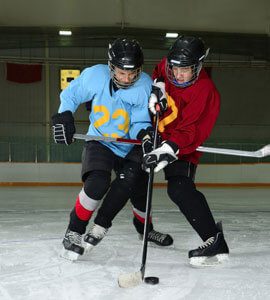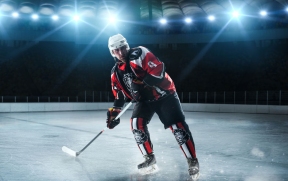While we tend to focus on practices and competitions when it comes to youth and collegiate sports, student-athlete off-season training shouldn’t be overlooked.
More kids and young adults are participating in sports than ever before. According to the Aspen Institute’s State of Play Report, over 76% of kids ages 6–12 and 73% of kids ages 13–17 play a team or individual sport.
From intense workouts and practices to competitive scrimmages and games, being a student-athlete can be physically and mentally taxing on young people. Using the off-season to train and condition—while also building in more time for rest and recovery—can help student-athletes come back healthy and ready to compete.
In this blog article, we’ll cover what you should know about student-athlete off-season training and how it benefits kids and young adults in competitive sports.
What Is Off-Season Training?
The “off-season” is when athletes aren’t participating in their sport (essentially, when there are no games/meets or regular practices). Different team and individual sports have different months when they compete, so off-seasons vary by sport and level.
From youth to professional sports, having an off-season is not only beneficial for recovering from the season but can also be a time for athletes to improve. Student-athlete off-season training allows time to build strength and endurance and work on individual skills that can improve overall performance.
Why Is It Important for Improving Performance?
The off-season isn’t a time for an athlete to lounge around for several weeks or months. (That could be detrimental to their performance when the season starts up and put them at higher risk of injury.) The off-season is, however, the right time for young athletes to back off high-intensity, competitive play in their sport.
During student-athlete off-season training, athletes can work on their technical skills at a lower intensity than during the season. (For example, a basketball player could work on their ball-handling skills or free-throw shooting.)
The idea is to focus on improving fundamentals while also conditioning and building strength. By working on skills and overall athleticism during the off-season, young athletes are better prepared for the higher-intensity demands of the competitive season.
With good student-athlete off-season training, young athletes can return to their sport even better.
3 Benefits of Student-Athlete Off-Season Training
There are many great reasons to participate in athletic training between seasons. Still, three of the most significant benefits of following a student-athlete off-season training program include:
- Improved Technical Skills and Increased Athleticism
- Building a Foundation for Higher-Intensity Activity
- Reduction in the Risk of Injuries During the Season

Teen goes for a run as part of her student-athlete off-season training program
1. Improve Technical Skills and Increase Athleticism
Increasing strength and athleticism can allow athletes to run faster, jump higher, and throw harder during their competitive season. If you look at any top athlete in their sport, you will likely find a person who prioritizes training in the off-season.
Lebron James hasn’t become one of the best basketball players in the world (and remains so well into his 30s) by laying on the couch and watching Netflix all day during the NBA off-season. He uses that time to train and keep his body in peak condition.
“Training as a lifestyle means committing to getting better at everything every day,” says Lebron’s athletic trainer Mike Mancias in an article for Tonal. “Holistically, it’s strength, conditioning, nutrition, sleep, range of motion, and mindfulness.”
Working on fitness and individual performance in the off-season is essential for young athletes interested in competing at the highest levels of their sport.
2. Building a Foundation for Higher-Intensity Activity
A well-rounded student-athlete off-season training program incorporates a balance of sport-specific skill work, aerobic exercise, and strength training. But off-season training doesn’t have to feel like boot camp.
Young athletes can use this time to change things up and try something new that still helps them achieve their fitness goals.
Doing different activities a student doesn’t typically get to do during the season can benefit the body and help prevent burnout.
For example, a track-and-field athlete may choose to spend more time doing lower-impact activities like yoga or swimming. This gives their joints a little break from all the running and jumping they do during the season.
The point of off-season training is to keep the body in good shape while giving the athlete a break from the grind of a competitive season. It allows them to recharge their batteries physically and mentally while still building a solid foundation for the coming season.
3. Reduction in the Risk of Injuries During the Season
The human body needs time to heal and recover after high-intensity sports, so doing nothing (or too much) during the off-season can be problematic. Going from zero to sixty on the court, field, mat, or in the pool puts young athletes at a higher risk for injury.
In his article for U.S. Masters Swimming, Chris Ritter discusses how important it is for competitive swimmers to work on their upper body strength to reduce their risk of injury in the pool.
“With many swimmers experiencing injuries, specifically in their shoulders, there’s a tendency to avoid exercises that use the shoulder exclusively.
This is backward thinking.
If you want strong, uninjured shoulders, you need to strengthen them in a balanced and progressive manner over time.
If you can perform push-ups and any number of strict pull-ups, your shoulders are more than likely going to be durable for many swimming seasons than someone who couldn’t perform those exercises.”
Learn the Signs of Youth Athlete Overuse Injuries
Planning Student-Athlete Off-Season Training

A good off-season student-athlete training program for young hockey players can improve agility, grow strength, boost on-ice explosive speed, and help with conditioning.
A common trap for young athletes and their coaches (and sometimes even parents) is to focus only on the short-term—scoring the most goals, taking first place, winning the big game, etc.
While these are great goals to strive for, they shouldn’t come at the expense of an athlete’s long-term health and performance. It’s important to remember the big picture and have a plan for the entire year.
Pushing too hard in the off-season or skipping student-athlete off-season training altogether are two extremes that can be harmful to a young person’s sports career and increase injury risk. Working with trainers and sports medicine doctors during the off-season is a great way to ensure a balanced training program for young athletes.
Each athlete’s needs for training are unique depending on their sport, level, position, and individual athletic abilities. Some may need to spend more time working on building strength, while others may need to improve conditioning or improving skills.
Student-Athlete Off-Season Training Schedule Example
A good student-athlete off-season training program generally incorporates a balance of aerobic exercise, strength training, sport-specific work, and periods of “active rest.” An athlete participating in an enjoyable activity different from their usual sport-related routine is considered active rest (e.g., yoga, hiking, kayaking, etc.).
Below is a general example of an off-season training schedule. (Remember, each athlete is unique and should consult a qualified trainer for a personalized program.)
Warm-up
Aerobic training
Cool down
Warm-up
Strength training
Sport-specific training
Cool down
Warm-up
Aerobic training
Cool down
Warm-up
Strength training
Sport-specific training
Cool down
Warm-up
Aerobic training
Cool down
Warm-up
Strength training
Sport-specific training
Cool down
Active rest & recovery
Sample of an off-season student-athlete training schedule
The most important thing to note in this example is that heavier training days are spaced out to provide adequate time for recovery.
FAQs About Student-Athlete Off-Season Training
If you have questions about student-athlete off-season training, the experts at IBJI have the answers. Here are some frequently asked questions.
What Are Things You Can Try to Improve During the Off-Season?
Student-athlete off-season training will vary by sport and the fitness needs of the individual athlete. But a few of the main areas that athletes may focus on in the off-season generally include:
- Strength
- Endurance
- Agility
- Speed
- Flexibility
- Core Stability
- Explosive Power
- Sport-Specific Skills
Are There Different Phases of Off-Season Training?
Student-athlete off-season training is often categorized into four main phases:
Hypertrophy/Endurance Phase
The hypertrophy/endurance phase of off-season training for student-athletes is typically designed to prepare young bodies for training by increasing muscle tissue size and improving anaerobic endurance.
Strength Phase
The strength phase of off-season training for young athletes is designed to condition student-athletes for movements essential to sports performance. It will focus more on sport-specific exercise applications.
Power Phase
This power phase of a student-athlete’s off-season is used to help young bodies grow and wield their strength, thus improving their ability to generate more explosive power quickly.
Pre-Season
As the off-season winds down, athletes start preparing for the season. During this phase, they’ll begin to increase their time spent on sport-specific training for a smoother transition into the higher-intensity demands of the season.
What Is the 20-Hour Rule?
The National Collegiate Athletic Association has established limits on how much time collegiate athletes can spend on games, practices, team meetings, or athletically-related activities.
Per these limits, student-athletes can only dedicate up to four hours per day and 20 hours per week to their sport during the season. They are also required to be given one day off.
During the off-season, the limit is eight hours per week with at least two days off.
Are Off-Season Training Recommendations Different Based on Your Sport?
Yes, student-athlete off-season training programs vary based on a student’s sport, level, and personal needs. It’s also crucial that the off-season be a time for the athlete to get a break from the demands of their sport and should include a balance of new and different activities.
According to the American Academy of Pediatrics, children in the U.S. have a higher risk of overuse injuries when specializing in a single sport. So instead of participating in their sport at a high-level year round, young athletes should use the off-season to allow their bodies to recover from the repetitive activities that can lead to injury.
For example, cross-country athletes may reduce their risk of injury, like runner’s knee, by reducing their running distance or duration during the off-season and increasing time spent on lower-impact aerobic activities like swimming or cycling.
Why Are Sports Physicals Important?
Sports physicals assess a student’s health and ensure they’re fit for safe participation in sports. Every student-athlete should have a sports physical before the season starts, regardless of their level or abilities.
The goal of the pre-participation sports evaluation is to determine a young athlete’s ability to compete safely and typically focuses on:
- Assessment of the Athlete’s General Health
- Evaluation of Existing Injuries
- Identifying Predispositions to Injuries
- Monitoring the Athlete’s Fitness Level
- Assessing Physiological and Developmental Maturation
- Evaluating Joint Flexibility, Mobility, Spinal Alignment, and Posture
- Assessing Speed, Agility, Power, Endurance, and Balance
- Detecting Poor Pre-Participation Conditioning That May Increase the Athlete’s Risk of Injury
Learn What Happens During a Sports Physical
Take Your Performance to the Next Level This Off-Season
IBJI’s Health Performance Institute (HPI) experts are here to help student-athletes perform their best and recover quickly from injuries. Our sports medicine team works with student-athletes of all ages and skill levels, from youth to collegiate sports.
Meet with our expert team to establish a treatment plan, track your health performance progress, complete physical therapy or athletic training, and return to your sport better than ever.
*This content is for information only and is not intended to replace the diagnosis, treatment, or medical advice from your treating healthcare professionals. The content does not provide medical advice, does not constitute the practice of medicine or other healthcare professional services, and does not create a doctor-patient relationship. You should not rely on this information as a substitute, nor does it replace professional medical advice, diagnosis, or treatment. If you have concerns or questions, seek the advice of your healthcare professionals. If you think you may have a medical emergency, call your doctor or 911 immediately. Do not rely on electronic communications or communicate through this website for immediate, urgent medical needs. This website is not designed to facilitate medical emergencies. The use of the information is at the reader’s own risk. The links are provided for information and convenience only. We cannot accept responsibility for the sites linked or the information found here. A link does not imply an endorsement of a site.




